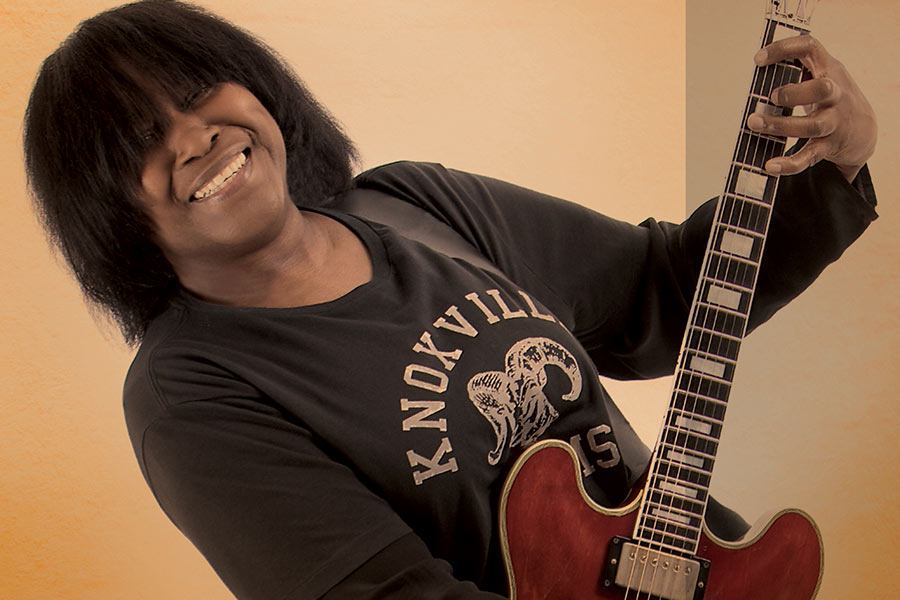For a woman at a crossroads of sorts, Joan Armatrading is alarmingly prompt and ready to go rather than say, resting on her laurels or cooling her formidable heels.
She phones early, talks plainly at length about her art and roundly makes certain that I know how focused she is on one particular thing when one particular thing is the focus – that being her last all-around-the-world tour and its local date, April 18 at the Grand Ballroom of the Scottish Rite Theatre in Collingswood, N.J.
“There’s no writing new songs or thinking about them either when I’m touring — just playing relentlessly, which I love until the end of this year,” she said in her soft St. Kitts, British accent. “Then I’m not.”
That same voice — only deeper and throatier — has filled the finest of English folk from the early ’70s until the present, a sound that only grew huskier, funkier and poppier with 1976’s “Joan Armatrading” (an album that made her an area radio favorite), and rockier with the all-electric likes of “Me Myself I” and “The Key.”
“I think 1976 was the year everyone finally caught on,” Armatrading said. “The eyes of the world were on me. Luckily, I didn’t really get involved with who liked me or how they liked me. For better or worse, I never got caught up in any of it, because I was never exactly in the right place at the right time. Yet, it all worked out.”
There were deep blues (“Into the Blues,” 2007) and jazzier interludes (“Starlight,” 2013) but, all in all, her repertoire is one long book and tremulous tone, and that volume is singularly Armatrading-esque — she is her own genre with its own patent. Mix her churning combine of showy, soulful folk with its poignant, focused prose — that’s personal but not probable or notably autobiographical — and the picture is complete.
Armatrading mentions how one of her most classic songs, “Down to Zero,” was about two women in two different couplings living the exact same life or having the same feelings, and it’s akin to Picasso discussing the squiggly lines in “Guernica.”
But she has her limits.
“I can’t help you,” she said when I ask how her personal life has guided her art form. “All I can say is that I’ve always been curious. I’m an observer. That’s what guides me. Even when I was in school, I was the watcher. Looking at how people communicated with each other, interacted. The ups and downs of their lives — it’s all very personal and then it’s not.”
(Armatrading has never been keen on discussing her civil union to her longtime partner, Maggie Butler, an artist who designed the cover of Armatrading’s 1979 live album, “Steppin’ Out.”)
Returning to her goals for 2015, she is singular.
“This is me on my own,” she said of her current tour, where all that will accompany her on stage is a guitar and a piano. “I’m mostly used to being with a band on stage, but I like it out there on my own, to tell you the truth. I write my own songs, produce and arrange them. I know where everything goes. And I know what I want, so it’s probably better this way.”
Armatrading doesn’t see herself as a woman or as an artist who compartmentalizes what she does. She doesn’t panic about the same things as other artists.
“I don’t get writer’s block. There are just the songs of mine I love and the few that I don’t, which you will never hear,” she said with a laugh.
She doesn’t see herself as slowing down just because she’s quieting her tour schedule or is nearing retirement age.
“I’m 64. Everything for me is next step. For the most part, that next step has been making music, then staying out on the road for a year. I keep going with no breaks. I don’t see the point of breaks.”
Armatrading is not tired or fed up, not in the least. She just wants to break the cycle and continue on the songwriting trajectory that found her last touching on the jazzier contours of her sound.
“I’ve always been an eclectic writer. I never stuck to one sound, mood or genre. Even when I do go and pick a genre, I can’t stick to one style within it. I think that’s why people like me.”
Asked lastly if she hears her life’s work as inspiration to any of folk-pop’s current crop, she laughed as she spoke.
“We are all inspired — I hope — by everything that we see and hear. But there is a fine line between inspiration and imitation, those inspired and those merely imitating,” she said, echoing the sentiment of people looking at Robin Thicke/Pharrell Williams’ “Blurred Lines” and Marvin Gaye’s catalog. “The ways that people research their art form are so very different from how they did so 40 years ago. You just have to be careful how you separate the two things.”

